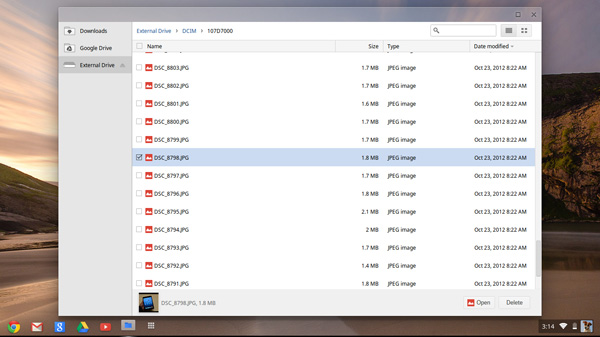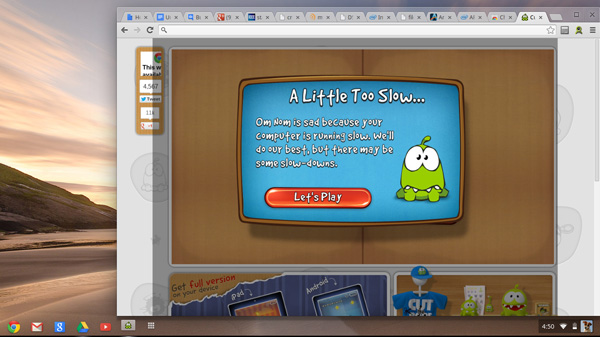Samsung Chromebook (XE303) Review: Testing ARM's Cortex A15
by Anand Lal Shimpi on October 31, 2012 9:00 AM ESTUser Experience & Usability
Similar to our performance analysis in the Surface review, there are really two sides to the performance of a Chromebook. There's the user experience as well as what the underlying hardware is capable of. I'll start with the user experience.
Chromebooks have never been all that robust when it comes to user experience. When Google first announced them they didn't even support mounting USB storage, although that has since been rectified. Although Google may have grand visions for where Chrome OS could go, today it serves one real purpose: to provide an affordable platform for a good web experience free of viruses and malware. To that end, the new Chromebook accomplishes its goal fairly well - as did the devices that came before it.
Chrome tends to be my favorite browser, and the experience maps fairly well the Chromebook platform. Web pages render properly and quickly (given the hardware that is). Compatibility isn't an issue. Everything just seems to work.
Obviously a major selling point of Chrome OS is that the web now allows for many content rich applications to be delivered directly in the browser rather than through a standalone executable. Google helps give access to these applications through the Chrome Web Store, although it's important to note that not all of them will run on the ARM based Chromebook (nor is there a good listing of those that will/won't run). The apps themselves vary in type from simple games to productivity tools. Many are quite functional, but the performance just isn't very good compared to a $500 tablet or even a $500 PC.
Technically the Chromebook can do a lot, but for anything other than browsing, YouTube and Google docs use I wouldn't get my hopes up. The heavier apps just don't run smoothly on the platform. Even web browsing isn't what I'd consider fast, but it's still acceptable. To put things in perspective, I got a performance warning trying to play Cut the Rope on the new Chromebook. Stability can also be a problem. Try to deviate too much from normal web browsing and you'll be greeted with long pauses and even system locks. For example, while testing WebGL performance on the new Chromebook I had to power cycle the machine after the browser became unresponsive. Normal web browsing is fine though.
There are other annoyances that aren't strictly performance related. For example, Netflix streaming won't work on the new Chromebook. Although image browsing support is native to the OS, there's no support for RAW camera files from a DSLR.
For the basic necessities however, the Chromebook does embody the fast enough computing concept. I researched, wrote and did almost all of my work while preparing this review on the Chromebook and generally found the experience acceptable. Other features like Pandora worked just fine (although I'd occasionally get hiccups in music playback if I loaded a particularly complex page). Whenever I'd switch back to my Ivy Bridge notebook I'd really appreciate the extra speed, but for writing and web browsing duties the Chromebook got the job done. Had Chrome OS been built around a lesser browser I don't think I would be as positive about the experience.












149 Comments
View All Comments
jeffkro - Wednesday, October 31, 2012 - link
Krait, might loose out to this A15 in all out performance but it is pretty great for battery life especially on LTE phones.Krysto - Thursday, November 1, 2012 - link
LTE has nothing to do with the chip. Those quad core S4 Pro's aren't even integrated with LTE yet. Latest LTE efficiency comes from the fact that it's made at 28nm, not at 45nm - the LTE chip itself that is.tipoo - Wednesday, October 31, 2012 - link
Impressive that the A15 beats Atom across the board, and draws significantly less power doing that. Complete leapfrog.eddman - Wednesday, October 31, 2012 - link
Not a valid comparison IMO when it comes to power consumption. That's an old 45nm Atom. Clover trail will do much better, thanks to the 32nm process and its new S0ix power states.tipoo - Wednesday, October 31, 2012 - link
Fair enough, but the performance per clock won't go up significantly until Silvermont.silverblue - Wednesday, October 31, 2012 - link
Still, the current Atom and Brazos are only mild updates (if that). The E2-1800 in HP's dm1 gets 547 in Sunspider, so clock-for-clock, Brazos 2.0 is ahead on this single test. However, the power consumption must be signicantly more. Still, slightly different markets.I would very much like to see the next Atom plus AMD's Jaguar; reduced power and better performance could make for a decent A15 competitor.
lmcd - Thursday, November 1, 2012 - link
Supposedly these were the leaky chips, so we could have a similar story in Samsung's favor.Krysto - Thursday, November 1, 2012 - link
Brazos has a much higher TDP though. Was it 10W for CPU and another 8 for the GPU? It's crazy.Krysto - Thursday, November 1, 2012 - link
Clover Trail is not a mobile chip. Only Medfield is, and they don't even have a dual core version yet. You will never see Clover Trail in smartphones (yet you will see Cortex A15), and the only reason you will see them in Windows 8 tablets is because Medfield would be too slow with Windows 8, and Clover Trail is more powerful, but also uses much more power, and they are willing to compromise on that, while lying through their teeth that it will get 8-9h of battery life. It will get nowhere close to that.wsw1982 - Thursday, November 1, 2012 - link
the clover trail is about 3.5+ w tdp according to some review. the samsung a15 is a 6+w soc. what make you think a 3.5 w soc cannot go to mobile, but a 6+w soc can?